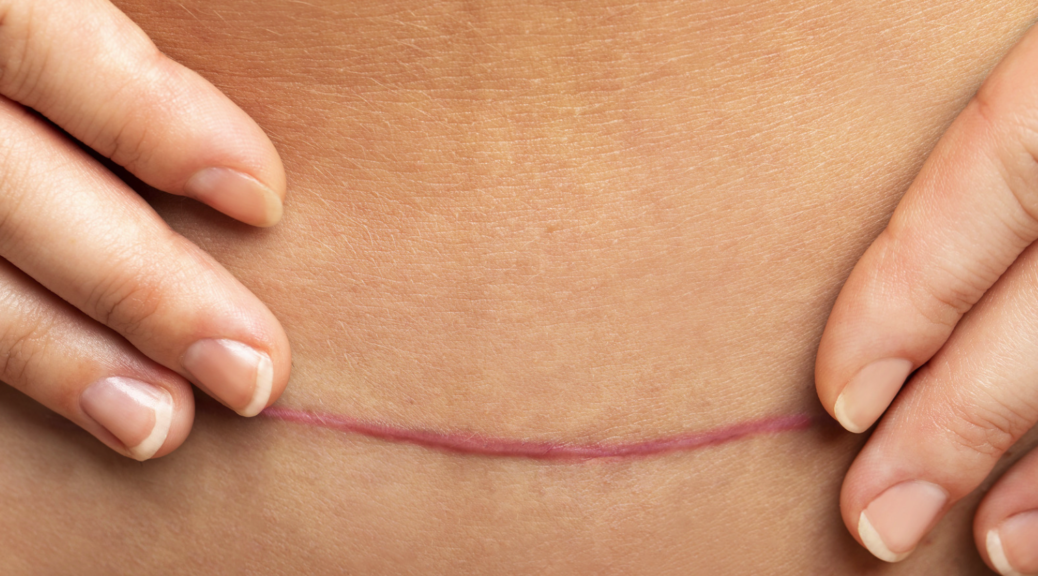
Recovery of obstetric scars
Scar tissue is usually less elastic than undamaged tissue. It can also create adhesions on different levels and affect adjoining and distant organs. In this article, we will discuss how obstetric scars can affect areas as complex as the vulva or when they affect so many layers, as in the case of a C-section scar.
Episiotomy
Episiotomy is a surgical procedure in which an incision is made in different layers (skin, vaginal mucosa, subcutaneous cellular tissue, and the bulbocavernosus and superficial transverse muscles of the perineum) to enlarge the opening of the vagina and facilitate the passage of the baby during the second stage of labor in case of emergency.
In no case is an episiotomy appropriate for the prevention of tearing, as it is related to deeper tears involving the anal sphincter. Currently, it is still inadequately performed in many vaginal births. When the indication is not due to an urgent need to deliver the baby quickly, it can be qualified as violence towards the woman’s body and is considered obstetric violence.
If necessary, at present, the most commonly used technique is the mediolateral incision, which is made in a direction of approximately 45 degrees laterally from the vagina towards the anus. Although it takes longer to heal, it tends to cause fewer complications at the anal level than medial episiotomy.
Tearing
Tearing occurs when the vaginal introitus must increase its diameter beyond what it can support, thus generating a perineal trauma.
There are different degrees depending on the involvement of the structures; the higher the degree, the greater the severity. The classification is as follows:
- Grade I: involvement of the perineal skin and vaginal mucosa (laceration of the vaginal epithelium)
- Grade II: lesion of superficial muscles of the perineum and vaginal epithelium, without involvement of the anal sphincter
- Grade III: involvement of the anal sphincter; it can be at the level of the external anal sphincter and in more severe cases, involvement at the level of the internal anal sphincter.
- Grade IV: involvement of the external and internal anal sphincter muscles and anal mucosa
Grades I and II of perineal tears are the most frequent. This type of tear does not usually require healing beyond adequate resting, hygiene, and some pelvic floor exercises. On the other hand, other perineal tears of higher grade (III or IV), do require thorough care in order not to end up generating pelvic floor alterations in the long term. These perineal tears can cause genital prolapse, urinary or anal incontinence, and fistulas if not treated correctly.
The difference between tears and episiotomy is that, although these usually require a long healing process, due to the fact that the tissue is broken in a disorganized way by the weakest parts, the impairment of functionality, in many cases, is less than in the case of an episiotomy.
C-section
A cesarean section is a surgical procedure where the incision involves 7 layers: skin, fat, fascia, muscle, peritoneum, uterus, and amniotic sac.
After a cesarean, there is a scar in the transversus abdominis. This is important because this is one of the main areas responsible for protecting and managing abdominal pressures, together with the diaphragm and the pelvic floor. Therefore, any untreated or poorly treated C-section scar can end up generating alterations in the pelvic floor due to a lack of activation of the transversus abdominis muscle when faced with increased abdominal pressure.
Scar treatment
Scar treatment is essential for the tissues to move and function properly again. In addition, correct treatment avoids adhesions and long-term discomfort.
Furthermore, scars influence at a muscular level, but also at a fascial level. So if you want to achieve a correct activation of the pelvic floor and abdominal region, a correct displacement of tissues and fasciae is essential.
Scar management includes the woman observing and familiarizing herself with the scar, performing breathing exercises, applying oil or moisturizer to the area, and applying a pressure massage on and around the wound.
It is important to keep in mind that scar management can generate a sensation of pulling, but it should not generate pain.
The main benefits of this scar management are:
- Improvement of the feeling of inflammation
- Decrease or relief of pain in the area
- Restoration of a normal sensation in the scar and surrounding area
- Improvement of tissue movement due to a decrease in adhesions
It is recommended to wait a reasonable time of 6 weeks for episiotomies or tears and about 8 weeks for C-section scars in order to assess and refer to a pelvic floor physiotherapist if appropriate.
Although it must be taken into account that each body is different, and depending on the degree of tearing and the quality of the woman’s tissue, these times may be different, so it is always advisable to look at each case individually according to the woman’s unique situation and respect the times required by each body.